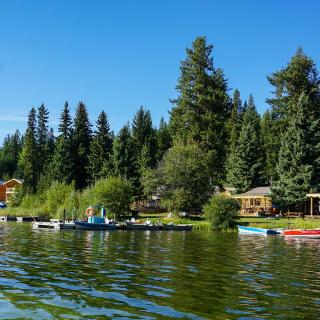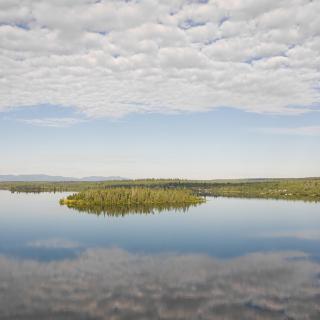
Lone Butte
Green Lake, BC | Flying U RanchLone Butte, British Columbia, has a rich history, transitioning from a bustling center for ranchers and loggers to a smaller, more rural community. It was once the largest town in the Cariboo region, surpassing 100 Mile House, with key industries like ranching and lumber mills.
Lone Butte History
The arrival of the Pacific Great Eastern Railway (PGE) in 1919 marked a pivotal moment in Lone Butte’s history. At an elevation of 3,900 feet, the town held a key position because the railroad did not have to haul water to operate the engines.
The water tower, completed in 1920, had a capacity of 40,000 gallons which provided the train, known as the Iron Horse with an abundant water source. This reliable water source was crucial for steam locomotives and also provided early settlers with a year-round supply of drinking water.
The railway station and water tower became the hub of Lone Butte and the community grew up around it. Through an agreement with the PGE in the late 1920s, water was piped in to feed the town water lines that serviced the hospital, hotel, post office, and store. The train service meant residents no longer had to make their annual journey to Ashcroft to stock up for the coming year. The Iron Horse also accommodated fresh fruit, building supplies, dry goods, and other items delivered weekly.
Ranchers also benefited, as cattle were brought in from Bridge Lake, the Bonaparte, and all areas in between before being shipped via rail to Squamish and then by barge to Vancouver.
However, the decline of steam trains and the development of Highway 24 eventually led to a shift, with 100 Mile House becoming the larger hub. Despite its reduced size, and the loss of the heritage hotel destroyed by a fire in 1998, Lone Butte continues to be a testament to its past, with efforts to preserve its history and heritage.
Things to do in Lone Butte
The Lone Butte Historical Association maintains a small museum highlighting the area’s railway heritage, indigenous history, and pioneer settlements. Visitors can explore the restored water tower and other artifacts that tell the story of this resilient community.
Today, the community provides essential amenities, including an auto repair shop, Post Office, convenience store with a gas station, pub/restaurant, coffee house, and a sporting goods store. The area also counts with a lively Community Hall that is home to the annual Lone Butte Rocks in July and Fireworks at Halloween, all open to the public. The year-round outdoor activities offer fishing for rainbow trout and kokanee in clear lakes to spotting moose, deer, and birds in nearby forests and wetlands.
The butte is a hardened plug of an ancient volcano and rises about 200 feet and rewards hikers with sweeping views. Trails around the region support hiking, biking, horseback riding, ATVing, and snowmobiling.
Nearby Green Lake Provincial Park offers five sandy beaches perfect for swimming and sunbathing during warm summer months. The park’s extensive trail system, boat launches, and camping facilities make it a popular destination for families and outdoor enthusiasts alike.
The area provides year-round outdoor fun, from fishing for rainbow trout and kokanee in clear lakes to spotting moose, deer, and birds in nearby forests and wetlands. Trails around the region support hiking, biking, horseback riding, ATVing, and snowmobiling. Lone Butte is also a low, steep-sided volcanic plug—also known as a mesa butte—located in southern British Columbia on the southern edge of the Cariboo Plateau, southeast of 100 Mile House.
Getting to Lone Butte
From Vancouver: Follow Highway 1 east to Hope and then north to Cache Creek, then take Highway 97 north toward Prince George. At 93 Mile House, turn east onto Highway 24 (The Fishing Highway) and continue for approximately 24 km (15 miles) to reach Lone Butte. The total driving distance from Vancouver is about 450 km (280 miles), typically taking 5-6 hours.
From Williams Lake: Travel south on Highway 97 for about 75 km (47 miles) to 93 Mile House, then turn east onto Highway 24. Lone Butte is approximately 9 km (5.6 miles) from the Highway 97 junction, making the total journey from Williams Lake about 100 km (62 miles) or just over an hour of driving time.
From Kamloops: Travel north on Highway 5 for about 110 km (68 miles) to Little Fort, then turn west onto Highway 24. Continue on Highway 24 for approximately 72 km (45 miles) to reach Lone Butte. The total journey from Kamloops is about 182 km (113 miles), or roughly 2 hours of driving time through scenic forested routes and lake country.
By Air: The nearest airports with scheduled service are in Kamloops (YKA) and Williams Lake (YWL), both offering connections to Vancouver. From either airport, rental cars are available for the drive to Lone Butte. For private aircraft, the South Cariboo Regional Airport at 108 Mile Ranch can accommodate small planes and is about 20 minutes from Lone Butte.
Accommodations & Attractions

Fawn Lake Resort
We are located 4km off Highway 24 in a quiet wilderness setting; only electric motors are permitted on Fawn Lake. We offer charming lakefront log cabins & RV/campsites with 15A power & water. Pets are very welcome. Amenities include motorboat,…
Lone Butte Fishing Adventures
We offer guided fishing trips along the Highway 24 corridor. Trips can either be Fly fishing, Gear Fishing or Ice Fishing. We are fully insured and boats are registered with Transport Canada. We can target Rainbow Trout, Lake Trout, Kokanee,…